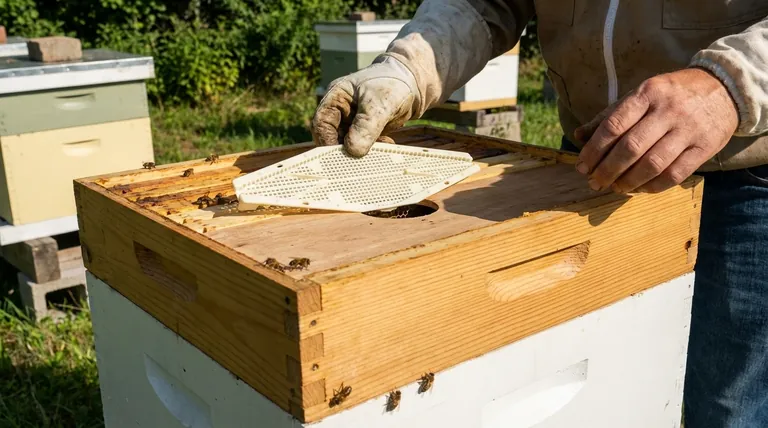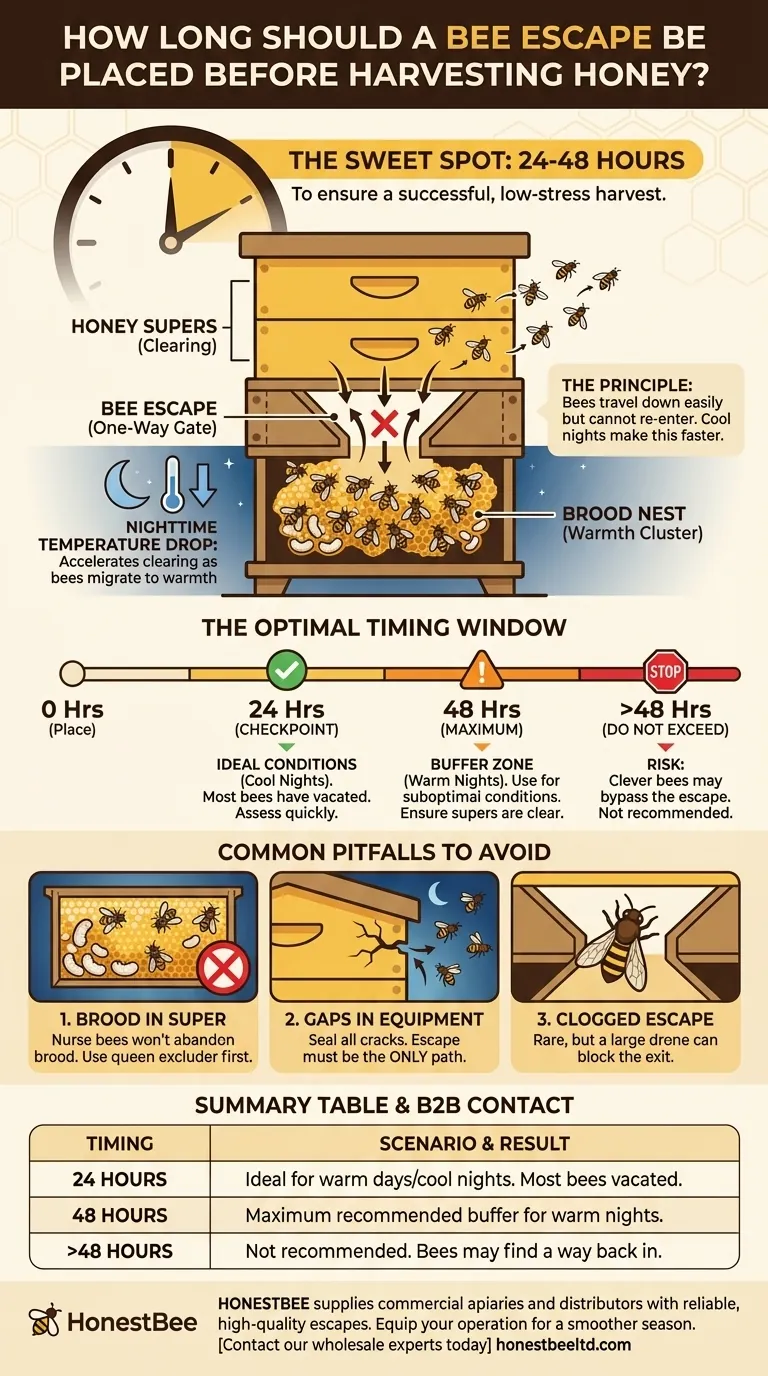To ensure a successful harvest, a bee escape should be placed on the hive for 24 to 48 hours. This timeframe provides the necessary window for worker bees to move down into the brood nest, leaving the honey supers largely empty and ready for collection.
The core principle of a bee escape is to create a gentle, one-way exit for bees from the honey supers. The 24-48 hour window is the sweet spot that balances giving the bees enough time to leave with preventing them from finding their way back in.

How the Bee Escape Works
A bee escape is a simple but ingenious tool designed to clear bees from honey supers with minimal stress to the colony. It relies on predictable bee behavior.
The One-Way Gate Principle
The device functions as a one-way valve. Bees can easily travel down from the honey supers and through the escape to reach the main brood chamber below.
However, the design of the escape makes it very difficult for them to navigate the path in reverse and re-enter the honey super they just left.
The Role of Nighttime Temperatures
The process is most effective when there is a drop in temperature at night. As the hive cools, bees naturally migrate downward to cluster together for warmth in the brood nest.
This natural instinct significantly accelerates the clearing of the supers, as the bees are actively trying to move to the area where the queen and brood are located.
The Optimal Timing Window
While 24-48 hours is the standard recommendation, understanding what happens during this period helps you adapt to your specific conditions.
The 24-Hour Checkpoint
After approximately 24 hours, the vast majority of bees should have vacated the supers. In ideal conditions with cool nights, the box may be almost completely clear.
This is often a sufficient amount of time for experienced beekeepers who can quickly assess the hive.
The 48-Hour Maximum
Leaving the escape on for up to 48 hours provides a buffer for less-than-ideal conditions, such as very warm nights when bees are less inclined to move down.
Do not exceed 48 hours. Given enough time, some clever bees may figure out how to bypass the escape, or they may find other cracks or entrances to get back into the supers.
Common Pitfalls to Avoid
For a bee escape to work, the entire system must be sealed. Any oversight can render the tool ineffective.
A Brood-Bound Super
The bee escape will not work if there is brood (eggs, larvae, or pupae) in the honey super. The nurse bees' instinct to care for the young is stronger than their instinct to move down, and they will not abandon the brood.
Always ensure your supers are brood-free before placing the escape. This is typically managed by using a queen excluder earlier in the season.
Gaps in Your Equipment
The bee escape must be the only way for bees to travel between the supers and the rest of the hive.
Check your equipment carefully for any cracks, holes, or ill-fitting boxes. Bees will exploit any alternative path, defeating the purpose of the one-way gate.
A Clogged Escape
Occasionally, a large drone can get stuck in the escape mechanism, blocking the exit for all other bees. While not common, it's a possibility to be aware of if a super remains full of bees after 48 hours.
Applying This to Your Harvest Plan
Use the timing guidelines to match your specific situation and goals.
- If you have ideal conditions (warm days and cool nights): Plan to remove your supers 24 hours after placing the escape.
- If conditions are suboptimal (very warm nights or unsettled weather): Give the bees the full 48 hours to ensure the supers are as clear as possible.
- If you are a first-year beekeeper: Remember that a new colony needs all its resources to survive winter, so harvesting honey is typically not recommended until the second year.
Properly timing your bee escape makes the difference between a stressful, chaotic harvest and a calm, efficient one.
Summary Table:
| Timing | Scenario & Result |
|---|---|
| 24 Hours | Ideal for warm days/cool nights. Most bees have vacated the supers. |
| 48 Hours | Maximum recommended time. A buffer for warm nights or suboptimal conditions. |
| >48 Hours | Not recommended. Bees may find a way back in, defeating the purpose. |
Ready for a calm, efficient honey harvest?
HONESTBEE supplies commercial apiaries and beekeeping equipment distributors with the reliable, high-quality tools needed for success—including effective bee escapes. Let us help you equip your operation for a smoother season.
Contact our wholesale experts today to discuss your equipment needs!
Visual Guide

Related Products
- High-Efficiency Diamond Maze Bee Escape for Clearing Supers
- Circular Labyrinth Bee Escape for Efficient Hive Management
- Efficient Hive Clearing: HONESTBEE 8-Way Plastic Bee Escape
- HONESTBEE Multi Exit Plastic Bee Escape Board for Efficient Honey Harvesting
- Slatted Porter Style Bee Escape for Rapid Hive Clearing
People Also Ask
- Where should the Bee Escape board be placed? For a Calm, Bee-Free Honey Harvest
- What happens if Triangular Escape Boards are left on for more than 24 hours? Risk of Bee Re-Entry and Failed Harvest
- What was the result of using the bee escape board? Achieve a Calm, Low-Stress Honey Harvest
- How long should the Bee Escape Board be left on the honey supers? Achieve a Peaceful Harvest in 24 Hours
- What is the result of using a bee escape board for 24 hours? Achieve a Near Bee-Free Honey Super



















